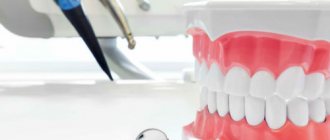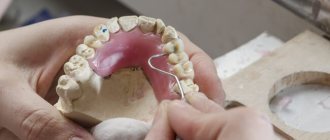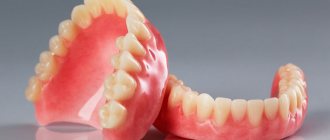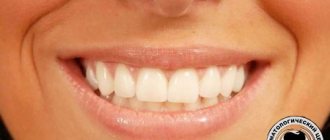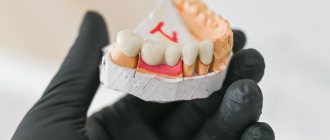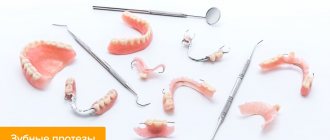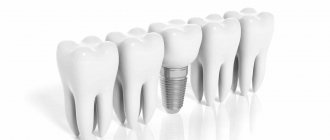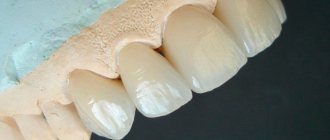Maxillofacial surgeon, implantologist Zaslavsky-Shostak Alexander Mikhailovich, who has been practicing implantation for more than 10 years, will help explain the process of dental implantation in a language accessible to the patient.
“Despite the popularity of the technique of using artificial “roots” and crowns to replace missing teeth, I still see in practice that about 50% of patients do not have a correct idea of what it is and how the process of dental implantation works due to various advertising messages, which only confuse a person ignorant of dental issues"
Stages of the implantation procedure
In modern times, implantation is carried out in several stages. This is more preferable for dentists and patients. The procedure is divided into the following stages:
- Initially, the patient is pre-consulted to identify contraindications and indications for the procedure. Dental, social and somatic factors may serve as contraindications.
- Then a detailed diagnosis is made using computed tomography and stereolithography. At this stage, the entire procedure is planned.
- Treatment measures are discussed with the client. He is provided with detailed information about the procedure and an agreement is concluded between the dental clinic and the patient.
- Dental therapists, orthodontists and periodontists prepare the workplace for the procedure.
- During the procedure, bone tissue may or may not be built up, and alveolar ridges and jaw bones may also be reconstructed. If necessary, they can make a somatic correction. Indications for the use of correction are the presence of diabetes mellitus and other diseases.
- At this stage, an implant is installed, defects are removed and the functions of the musculoskeletal system are restored.
- As a result of the procedure, the patient’s condition is monitored and a preventive examination is performed.
Methods for installing a dental implant
There are different types of dental implants:
- one-piece;
- two-part;
- classic root-shaped;
- basal;
- compression and others.
The choice of implant model depends on the method of its installation. There are several ways to install dental elements:
Flap method of implant installation
The flap technique for installing dental implants is carried out in several stages:
- At the beginning of the procedure, it is necessary to numb the place where the dental element is installed, that is, anesthesia is performed.
- Then the gums are treated with an antiseptic.
- At this stage, incisions are made on the gum - one is made along the gum, the other two across. This is done in order to form a kind of “flap”. It is thanks to this flap that you can approach the bone tissues of the jaw.
- A hole for an implant of a certain size is made in the bone tissue using special dental instruments.
- It is then screwed into the bone tissue.
- Sutures are placed on the gum, restoring it to its previous condition.
After this method of installing dental elements, it is recommended to monitor your food intake for one or two weeks and consume solid foods in minimal quantities.
After the procedure, some complications may occur. This may include bleeding from the wound, pain in the gums and teeth, the stitches may come apart, which will lead to infections, the tissue around the implant will become inflamed and the structure will be rejected.
To avoid all these processes, it is recommended that after carrying out the procedure using this method, if any undesirable processes are detected, immediately contact a specialist.
The positive aspects of installing dental elements using this method are the following:
- This method has been used for quite a long time.
- Possible complications are minimized because this technique has been used in practice in the most complex and less common cases;
- The procedure using this technique is painless because the patient does not feel anything during the surgical procedure, thanks to anesthesia.
- The implant is practically invisible, which creates an aesthetically pleasing smile. The gums remain as smooth and beautiful.
Minimally invasive (transgingival) method of implant installation
This method of installing dental elements is considered quite fast and without damaging the tissue. This technique uses one-piece dental implants that are screwed into the bone tissue directly through the gums.
During the procedure using this method, no incisions are made, that is, no surgical intervention is required. The transgingival procedure is performed in several stages:
- First, the site where the dental element is installed is anesthetized.
- Then a hole is created and a section of gum that corresponds to the size of the implant is removed. There is virtually no bleeding during the creation of the hole.
- Subsequently, the implant is inserted. The process of fusion of bone tissue and implant begins immediately after its installation. A few months later, crowns or dentures are installed.
The positive aspects of using this technique are the following:
- The duration of the operation is short.
- The recovery period is also minimal.
- There are no unpleasant sensations after the operation.
- There is no chance of tissue infection.
- There is no chance of implant rejection.
- No surgery required.
- No bleeding during surgery.
Lateral implantation technique
This technique is used quite rarely, since there is a possibility of implant rejection by the gums and bone tissues. This method is the fastest, since the crown is attached almost immediately after installation of the implant. This technique allows you to preserve the volume of bone tissue in the area of the extracted tooth, as well as the volume and contour of the gums, which is very important for obtaining good aesthetics of the gingival margin around the implant. The procedure for this method is performed in several stages:
- First, the first thing to do is numb the place where the dental element is installed.
- A small puncture is then made in the bone tissue to place the dental implant. It must match the size of the dental element.
- Lateral implants are inserted from the side of the jaw.
- After installing the lateral implant, a temporary crown is installed, thanks to which there will be no problems during chewing.
- The permanent prosthesis is installed after its manufacture.
The positive aspects of using this technique in practice are the following:
- Treatment is carried out as quickly as possible.
- This procedure can be performed on patients with a low pain threshold without using anesthesia at all.
- During the operation, the patient does not experience discomfort.
- Treatment can be carried out with a small amount of bone tissue.
- Possibility of installing an implant on the day of tooth extraction.
- Chewing function is restored quite quickly.
- The patient receives virtually no radiation exposure, since X-rays are taken in extremely rare cases.
The one-step implantation method is also quite fast. The dental element is installed almost immediately after tooth extraction. The procedure for this method is carried out in several stages:
- First, an image is taken to make a temporary crown.
- Then a hole is made in the place of the removed tooth.
- An implant is inserted into the hole made. With this method, one-piece and two-piece implants can be installed, depending on the condition of the bone tissue and the health of the patient.
- After installing the dental element, a temporary crown is installed, the permanent prosthesis is installed after complete healing of the structure.
Before carrying out this procedure, the patient’s oral cavity is examined to determine the presence of caries or defects. This method can be used in the following cases:
- If there is a need to remove a severely damaged tooth.
- In case of severe tooth trauma with deep penetration under the gum tissue.
- If it is not possible to install dentures in place of the extracted tooth.
- For urgent restoration of anterior teeth.
- For diseases of the gums and teeth, when a tooth needs to be removed.
To carry out this operation, certain requirements must be met:
- There should be no large-scale destruction of the dental bone tissue.
- There should be healthy gum soft tissue around the extracted tooth.
- There must be the required amount of bone tissue.
- Inflammatory processes should not be present on the upper part of the root of the extracted tooth.
- The partitions between the roots must be preserved, provided that the extracted tooth is multi-rooted.
- There should be no atrophic changes in bone tissue.
There are also contraindications, which include:
- Allergic reactions to painkillers.
- Periodontal disease, periodontitis, osteoporosis.
- When immunity is reduced.
- Blood diseases.
- Presence of psychological illnesses.
- If you have cancer.
- For AIDS, sexually transmitted diseases, etc.
The positive aspects of using this technique in practice are the following:
- Short treatment period.
- Minimum indications of injury hazard.
- Minimum load readings on the installed prosthesis.
- There is a short recovery time and a minimal incidence of complications.
- The cost of dental implantation is low, the procedure is considered the least expensive (you can find out how much it costs by scheduling a consultation with a specialist).
- Long term use of implants. Such dental elements last for more than twenty years.
- The aesthetic appearance of the tooth is restored and, accordingly, a healthy smile.
- It is one of the most comfortable procedures, as it is painless and without discomfort.
- Natural gum contours are preserved.
- There are no gum incisions.
- Anesthetics are used in minimal quantities.
The one-step technique can be used both with partial and complete absence of teeth.
Our clinic staff create a comfortable environment for patients awaiting implantation. Well-coordinated, professional work of the team, for whom dentistry is not a job, but a vocation, will bring satisfaction to every client.
Sequencing
- Creation of a plaster model. Considering that the impression is made of metal ceramics or zirconium dioxide, this stage may take several weeks.
- Preliminary fittings. At the first stage, the base of the prosthesis is tried on, at the second stage - a structure with applied balls of ceramics and coloring matter. The following fitting allows you to evaluate the chosen shade, the shape of the crown, and make the necessary changes.
- Re-sent to the dental laboratory for final polishing.
- Fixation of the crown with temporary dental cement. This is necessary so that the patient can evaluate the quality of the fit, as well as to exclude allergic reactions.
- If discomfort is detected, the doctor takes measures to eliminate it. If no problems are identified, the prosthesis is fixed with a permanent composition.
Implantation with laser
This method of implantation is the most advanced and technologically advanced. The operation is carried out practically, like the classic procedure, but instead of a scalpel, a laser is used to cut the gums. The percentage of engraftment is the highest and reaches almost 100 percent. Laser technology is used in the following situations:
- If the gum is cut and the dental implant is not installed immediately after healing.
- If the mucous membrane is re-opened, that is, with two-stage implantation.
- When the gum restoration process is carried out.
Implantation using a laser is carried out in several stages:
- First, preparation is carried out, during which the weight of the future tooth is calculated. This is necessary in order to understand what kind of load the gums will experience. If the dentist believes that there may not be enough bone tissue to perform the operation, then a sinus lift is performed (bone tissue is built up).
- Then the implant is inserted. But before this, a small incision is made using a laser; it is into this that the dental element will be inserted. It is implemented using high-tech and sensitive equipment - a physical dispensary. After implantation, sutures are placed on the laser-cut gum. Then a temporary crown is installed.
- Next comes the recovery process. Depending on the characteristics of the human body, this process can take from two to six months. During this time, the dental element must grow together and become accustomed to the bone tissue.
- After the implant has completely taken root, the second stage of laser implantation is carried out. Using a laser beam, the gums in the healed area are opened and a permanent crown is installed. It can be made of metal ceramics, metal-free ceramics, zirconium and titanium.
The main positive aspects of using this method are the following:
- Bleeding during the procedure is almost completely absent, since the gums are cut not with a scalpel, but with a laser beam. The laser beam instantly burns through the blood vessels. Due to the fact that there is no bleeding, there is no likelihood of inflammatory processes.
- The incision is made with a minimum length, on average it is made one centimeter long for each extracted tooth. The bone tissue is evaporated, so there is virtually no damage. The procedure is considered virtually non-traumatic, since this indicator is minimal. The tissues are restored and healed quite quickly. After installing a permanent prosthesis, you can return to your normal lifestyle and eat all foods.
- This operation using a laser takes a minimal amount of time. Within half an hour, the dentist makes an incision in the gum, implants a dental element and sutures the cut gum tissue.
- The procedure is completely sterile, since the laser beam has bactericidal properties.
- Side effects are practically absent completely. When using a scalpel, the dentist cannot guarantee that there will be no ingress of metallic dust. Metal particles can react with the surface of the implant, become electrified, and thus the patient will experience uncomfortable sensations. With the laser cutting method, this possibility is impossible.
- Anesthesia is used in minimal doses. Due to the minimal risk of injury and pain, a minimal amount of anesthetic is used to numb the incision site. In addition, it reduces the burden of drugs on the human body.
- Lack of psychological discomfort. From a psychological point of view, this operation is much easier, since it is not associated with bleeding gums. From the patient's point of view, cutting with a laser beam is less traumatic.
- The period of use of the implant is almost lifelong. The dental element is attached to the jaw very firmly, practically like a healthy tooth, therefore the period of use of the implant is very long.
The indications for the use of this laser method are practically no different from the indications for traditional implantation with a scalpel. An implant can be implanted using this method in any age category.
Fixed dentures supported by your teeth
- When to place: if 1-4 teeth are missing in a row, and at least 1 healthy tooth or root should be preserved on each edge of the “empty” space. We are talking about dental bridges or bridge-like prostheses.
- Wearing period: in most cases, this is a permanent fixed prosthesis, so such a prosthesis will last approximately 5-7 years.
The most popular method of prosthetics after root removal is a bridge structure or, more simply, a dental bridge. These are several artificial crowns connected in a row. Moreover, the central ones replace missing natural crowns (there are no roots under them), and the outer ones are fixed on natural teeth or their roots. That is, in order to restore 1 extracted tooth, you need to use two adjacent ones for support. Which does not have a very good effect on their service life. After all, the supports need to be sharpened, the “nerves” (neurovascular bundles) removed from them - so they receive less useful substances in the future.
There is a temporary version of the bridge structure - this is an adhesive bridge. It does not have end crowns, but instead there are plates or “wings” on the sides of the artificial crown that are glued to the abutments on one side. However, the fixing composition and shape of the fasteners cannot provide a reliable connection for many years. Therefore, adhesive bridges often come off when chewing.
The advantage of bridges is that they are highly aesthetically pleasing – especially those made, for example, from E.max ceramics from Ivoclar Vivadent, glass ceramics from VITA Zahnfabrik or Prettau zirconia. Metal-ceramic crowns during operation reduce the aesthetics of a smile, because... may cause “blueness” of the gums. If you choose metal ceramics, it is better to give preference to quality brands. For example, IPS Classic from Ivoclar Vivadent, Duceram from Dentsply Sirona, and Kuraray Noritake.
Non-surgical dental implantation
Dental implantation in dentistry can be carried out using various methods. The methods for performing this operation were described above. Non-surgical methods for installing a dental element are express methods, which include lateral, one-stage and others.
This non-surgical method is also called one-stage, seamless, with minimal risk of injury. With this technology, tissues are practically not injured. In this case, there is no need to build up bone tissue and the stress on the gums and healthy teeth is minimal.
Express methods include the following:
- Instant installation of implants. In this case, the dental element is installed immediately after the diseased tooth is removed.
- Implantation with immediate loading is the main express technology. In this case, one-piece structures are used. They are fixed with minimal traumatic risk.
- Mini-implantation involves the use of small-sized implants. They are auxiliary fixators of removable dentures. This is necessary in order to prevent them from slipping out of the mouth and making them more comfortable to wear.
In modern times, one of the most popular and in demand is implantation with instant loading.
Non-surgical installation of implants
If the patient chooses implantation with immediate loading, he saves himself from surgical intervention, which occurs in several situations:
- When it is necessary to adjust the volume of bone tissue. In such a situation, dental implants have a distinctive feature - they can be installed even where there is a small amount of bone tissue. The shape and thread of the dental elements allow for painless installation. There is no need to build up bone tissue with this method of tooth restoration. To fix the dental element, the bone shell of the jaw is used, as well as the basal layer. Neither the tunica nor the basal layer will be reduced even in situations of severe atrophy. They will remain just as strong and firmly fix the implant.
- When it is necessary to implant a dental element into bone tissue. If conventional implants are used, then a rather complex operation must be performed. It is necessary to cut and peel off the gum, then drill a hole of a certain size in the bone and then install the dental element. After the structure is fixed, the gum is sutured. After the implant has healed, the gum is cut again and a crown is installed. When using one-piece dental structures, such moments can be avoided. No incision is made, just a puncture is made, into which the dental product is subsequently screwed into the bone tissue. The risk of injury is reduced to a minimum.
Thus, we can conclude that non-surgical implantation exists. Such operations are carried out using immediate loading. The method serves as express prosthetics. After the implant is installed, impressions of the tooth are taken to create permanent dentures. They are installed after two or three days.
With this method of restoring teeth, the load on the teeth will be distributed evenly, this is a feature of the technology. Bone cells will evenly receive the necessary nutrients for growth. The tissue regenerates quite quickly, which leads to the natural functioning of the oral cavity.
Removable dentures (traditional)
- When to place: in the absence of any number of teeth - one, several or all.
- Duration and features of wearing: temporary prosthetics, the prosthesis will last 3-5 years. They are relevant if there are contraindications to fixed prosthetics - pregnancy, in childhood, with serious diseases of the body (when it is not recommended to give anesthetic injections and perform surgical interventions), with a small budget for treatment.
REPROSTHETICS WITH ACRYLIC PROSTHETICS - RUB 150,000. instead of 180,000 rub. until January 15, 2022!
Re-prosthetics with an acrylic bridge on a metal frame (all included) up to 12 units.
Call now or request a call
As a rule, removable dentures supported by gums or remaining teeth cannot provide high aesthetics, since their fastenings in the form of hooks (especially metal ones) are visible from the side. It is difficult to chew food with them, because... fixation is unreliable. Most removable dentures dent due to softness, loose fit, or rub the gums to the point of ulcers and injure the supports. Also, structures often fall out of the mouth while eating or talking. Therefore, patients have to use a cream to adhere the base to the gums (for example, Corega or Protefix).
Removable prosthetics for single defects
If we consider the situation that the patient is missing only 1-2 teeth along with the root, then the orthopedic dentist can offer “butterfly” prosthetics. This is a miniature orthopedic structure consisting of artificial crowns, surrounding artificial gums and hooks along the edges, which are fixed to adjacent dental crowns (natural). It is very difficult to chew food normally, so you should choose this solution only on a temporary basis.
If you don't have a lot of teeth
Here they install more massive versions of removable structures - for example, clasp ones (on hook-clasps, clasps-attachments or telescopic crowns). Their advantage is that they distribute the chewing load quite well due to the presence of a metal arch - a clasp, and also have a small palatal bridge.
For the same indications, you can install classic acrylic removable dentures with hooks for fixation on the remaining teeth. Or nylon - they are more convenient, because... the material is elastic, but stretches over time and cannot be repaired. Removable structures Acry-free (“Acry-free”), Quattro Ti (“Quadrotti”), and sandwich dentures are considered more comfortable to wear compared to conventional acrylic ones.
It is worth mentioning separately about “Quadrotti”, which are considered metal-free analogues of clasp ones. They, like the “clasps”, do not have a large palatal overlap, but only a thin bridge. The remaining removable structures will be equipped with a massive sky - and the fewer units left in the row, the more massive it is.
Removable prosthetics with complete edentia
If all the teeth are missing along with roots suitable for prosthetics, clasp structures can no longer be placed, just like sandwich dentures. The patient can choose between other removable ones - acrylic, nylon, polyurethane and Acry-free. Since the prosthesis is attached only to the gums and only due to the “suction cup effect,” the quality of fixation of such products leaves much to be desired. Many patients often say that they cannot get used to the massive prosthetic structure (because they begin to feel sick or produce a lot of saliva) or are completely unable to chew with it. That is, such an artificial “jaw”, at best, can provide the beauty of a smile, but you can forget about functionality.
Implantation immediately after tooth extraction
Based on statistics, surgery on the lower jaw is more successful than installing implants on the lower jaw. This factor depends on different bone densities.
As a result of an immediate operation, where there is an immediate load on the dental element, the possibility of rejection of the implant from the bone tissue increases. In many cases, complications can arise due to the characteristics of the human body to foreign elements. In principle, the percentage of complications from the instant technique to other implantation methods is almost the same.
The main advantage of using this technique is that the implant can be installed immediately after removing the diseased tooth. If there is a chronic infectious focus on the upper part of the tooth root that will be removed, then this is an indicator of the risk of complications in a minimal percentage.
But this also does not serve as a contraindication to the procedure. If the patient is a smoker, then dentists do not recommend using this method of dental restoration. Also, such an operation cannot be performed if you have osteoporosis or poor oral hygiene.
If the patient does not want to waste time going to the dental clinic, then with this method they can remove the diseased tooth and immediately install an implant. For many, this is an undeniable advantage.
Important : It must be taken into account that when carrying out immediate dental implantation, in many cases it is necessary to plant bone tissue, and a barrier membrane can also be used. It is necessary in order to regenerate bone. The use of a fit is necessary in situations where the diameter of the dental element is smaller than the size of the puncture at the site of the extracted tooth. That is, between the dental element and one of the bone walls there will be an empty space that needs to be filled with bone material.
Which method is better to choose?
When choosing a smile restoration method, you should rely not only on its cost, but also on the comfort of use. Here, fixed prostheses on implants simply have no competitors. About 90% of patients, even 5-10 years after implantation, declare that their quality of life is as high as that of people with their own teeth. That is, the diet is varied, there is no pain and inflammation in the dental system, and the smile maintains high aesthetics. Many people note that their face looks younger and that facial wrinkles have smoothed out.
Whereas 60% of people who chose classic removable structures say that if they knew how uncomfortable dentures are, how they rub and do not protect against bone loss, they would look for better quality prosthetics or implantation. Those who wear bridges, 5-7 years after their installation, begin to regret that they “ruined” healthy supporting teeth, and now they have collapsed from overload. As a result, they had to be removed and a longer bridge or removable denture installed.
“Mom tried to wear a removable jaw for several years, but for some reason it didn’t suit her. She says that it is very uncomfortable with her. You can't do anything except smile. And it’s generally impossible to eat. My brother and I decided to give her an anniversary gift. We found a good clinic and persuaded my mother to undergo All on Four implantation. She, of course, was afraid at first, but then she appreciated it. He says he should have done this earlier and not have suffered.”
Julia P., review from prodoctorov.ru
Therefore, it is better to place 1 crown on an implant than a classic bridge - and these methods are comparable in price. A fixed prosthesis is better than a removable one, because... more convenient, firmly fixed and small in size, which makes it easier to get used to, care and use. But, of course, it is also important to evaluate your health and financial capabilities, together with a competent doctor, so that the type of prosthetics really suits you.
1Martin U., Chappuis V. Implantological treatment in an aesthetically significant area. Modern protocols for single tooth replacement, 2019.
Your questions and answers
QUESTION Hello, I have a problem with my front tooth. Almost every two years I treat him, but the caries comes back again. Moreover, the dentist said last time that, most likely, it would have to be removed along with the root. Which prosthesis is better to install? Alexei
ANSWER Hello, Alexey. The best option is to install an implant with a zirconium dioxide crown. This way you will fully restore the extracted tooth. By the way, you can even do one-stage implantation, i.e. place an implant on the day of removal of a damaged tooth. Another option, but of lower quality, is a bridge. But the bridge will have to rest on something, in this case it will be necessary to use 2 adjacent healthy teeth for support. As a result, they will irreversibly lose part of the enamel due to grinding, and the dental “nerve” will also be removed. Also, the supports will experience increased load and fail faster.
Author: Chorny S.V. (Thank you for your help in writing the article and the information provided)
Contraindications for implantation
Before performing an implantation procedure, the dentist must check the patient for possible contraindications. They are divided into several varieties.
Absolutes include the following:
- blood diseases;
- if there are malignant tumors;
- with immune pathology;
- if there are diseases of the central nervous system;
- if bisphosphonates are taken orally;
- in the presence of lupus erythematosus, rheumatoid arthritis, rheumatism, scleroderma;
- if you have tuberculosis;
- if there is recurrent stomatitis or pemphigus;
- if the function of the masticatory muscles is impaired;
- diabetics.
Relative contraindications include the following:
- Lack of oral sanitation.
- Poor oral hygiene (this is a good reason to prescribe removable dentures).
- For gingivitis.
- If there is marginal periodontitis.
- For pathological bites.
- For diseases of the temporomandibular joint.
- If there is severe atrophy or damage to bone tissue.
- If the patient smokes, drinks alcohol and drugs.
- When pregnant.
General contraindications consist of the following:
- Surgical reasons for refraining from any intervention.
- Contraindications to pain medications (negative tolerance to anesthesia).
- Certain somatic diseases that may be affected by the procedure (these include endocarditis and other heart diseases, rheumatism, etc.).
- Certain treatment methods can have an impact on the regeneration and preservation of the dental element after installation, on the tissue surrounding the dental element (if various types of depressants, anticoagulants, cytostatics and other agents are used).
- Diseases of the central nervous system.
- Distress syndrome (severe and prolonged stress, which is caused by all sorts of reasons).
- If there is exhaustion of the body.
- Poor oral hygiene (this is a good reason to prescribe removable dentures).
Local contraindications consist of the following:
- unsatisfactory tendency to oral hygiene;
- insufficient presence of bone tissue or its inappropriate structure;
- unsatisfactory distance to the maxillary and nasal sinuses.
Temporary contraindications include the following:
- acute diseases;
- rehabilitation and health stages;
- pregnant condition;
- addiction;
- condition after irradiation (the implantation procedure can be done after a year).
Which prosthesis to put if the tooth root is removed - we consider all the options and choose the best one
Article navigation
- Indications for removal along with the root
- Prosthetic methods
- Removable dentures
- - for single defects
- - there are not many teeth
- - with complete edentia
- Fixed dentures supported by your teeth
- Supported by implants
- — restoration of 1-2 teeth
- - from 3 missing teeth in a row
- - full recovery
- Which way is better?
Question for a specialist
Many people, for one reason or another, lose teeth - one or several at once, or all, but gradually. This is often caused by injuries, aggressive caries, general diseases of the body, and even the fear of going to the dentist for treatment. But it is necessary to have prosthetics, otherwise problems with the gastrointestinal tract will begin, early wrinkles will appear, not to mention the unaesthetic appearance of the smile. Next, we will tell you what methods are used for prosthetics of teeth without roots - and which option is considered optimal.
Complications following dental implantation
The use of modern implantation methods and high-quality dental products has made it possible to increase the popularity of this method over the previous twenty years. On average, the survival rate of dental elements over a period of 7-10 years is currently at almost one hundred percent success level. Moreover, success rates in the lower jaw are higher than in the upper jaw. This depends on the fact that the lower jaw bone is the densest.
To conclude, rejection of dental elements is not common, and the main reason for patient dissatisfaction is the deterioration of the aesthetic appearance where the gums are adjacent to the dental element. At the initial stage, it may look like a not very noticeable cyanosis of the gums, which will increase over time. Over time, gum recession may occur, that is, the neck of the dental element may be exposed.
This all occurs due to bone resorption near the neck of the dental element, as a result of which the metal part of it, which is deprived of bone tissue, begins to be visible through the gums, which gives a bluish appearance. The subsequent decrease in bone level results in loss of bone support and a reduction in bone level following the bone. Gum recession appears.
Based on practice, the occurrence of bone resorption and recession is only caused by errors and shortcomings of the treating dentist. The most common mistakes are:
- There is a thin bone wall (less than two millimeters) on the side of the front surface of the dental element, and the dentist, observing this, did not replant the bone, which leads to resorption of the upper part of this bone wall.
- Thin gum (two millimeters or less) on the jaw crest of the alveolar process, which does not allow the formation of the required volume of soft tissue near the dental element, and the dentist, observing this, did not increase the thickness of the gum. This could be done by transplanting a small flap of mucous membrane from the palate.
- Small distances (less than three millimeters) that separate the lateral surfaces of the dental element from the adjacent teeth or other dental elements, which leads to resorption of the lateral bone septa and a decrease in the level of interdental papillae.
In addition, there are other reasons, so you need to contact a competent specialist.
Requirements for the surviving part
Unfortunately, fixing the prosthesis to the tooth root is not always possible. To do this, the latter must satisfy a number of requirements:
- have strong walls and be long enough;
- not be affected by caries;
- be well passable (otherwise it will not be possible to seal it);
- have walls of the required thickness to hold the inserted pin and withstand the pressure exerted during chewing food;
- do not have inflammatory changes in the upper part.
If the root is very curved, it is very small in size, it will not be possible to use it during prosthetics. The situation is similar if there are fistulas in the gums that do not go away even after filling.
Is implantation technology right for you?
Dentists at the Presidential clinics take a responsible approach to various operations, including implantation. Our main goal is to achieve a completely flawless, comfortable and aesthetic result for the patient, which will serve as an exact copy of a natural tooth. We carry out implantation when we are one hundred percent sure of the effectiveness of the result.
Before the operation, the patient is consulted and a contract is drawn up. This stage is focused on a correct assessment of the prospects and the very possibility of implantation in each specific case.
During the consultation, the specialist carefully examines the condition of existing teeth and gums, assesses the density and volume of bone tissue. For accurate results, radiography is used, which displays the features of the bone structure in the place where dental elements will be installed.
Only based on the results of the examination, the specialist decides:
- is it possible to carry out implantation;
- what procedures need to be carried out before surgery;
- how long will the entire procedure last?
- total cost of services provided.
In various situations, dental implantation can be done only after augmentation of jaw bone tissue, gum tissue grafting or sinus lifting. Such operations in dental clinics are performed by specialized employees, and their cost is negotiated immediately after the consultation.
Also, in specific situations, you can do alternative implantation, which uses mini-implants made of titanium. Our dental network will try to do everything possible to return you to a healthy smile and your old lifestyle, freeing you from the problems associated with insufficient natural dentition.

